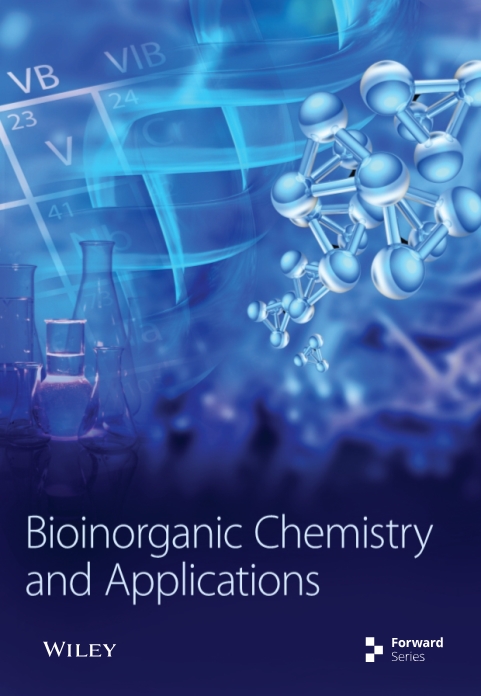纳米姜黄素覆盖Au@ZnO纳米复合材料对金黄色葡萄球菌α-溶血素产生的抑制作用
IF 4.7
3区 化学
Q1 BIOCHEMISTRY & MOLECULAR BIOLOGY
引用次数: 27
摘要
采用激光烧蚀法制备氧化锌金纳米粒子(Au@ZnO NPs),再包覆姜黄素纳米粒子(Cur-Au@ZnO NPs)。利用透射电子显微镜(TEM)、傅里叶变换红外光谱(FTIR)、紫外-可见光谱和x射线衍射等技术对合成的NPs进行了表征。此外,通过琼脂孔扩散法和AO/EtBr染色法检测了NPs对金黄色葡萄球菌的抑菌能力。结果表明,制备的纳米颗粒(Cur-Au@ZnO)具有抗菌作用,可以破坏细菌的细胞壁完整性,穿透细胞质膜破坏细菌细胞。此外,研究结果证实了形成的NPs在减弱金黄色葡萄球菌对大鼠胚胎成纤维细胞(REF)的粘附和侵袭中的作用。此外,通过western blot技术、人肺泡上皮细胞(A549)和小鼠模型的组织病理学检查,评估Cur-Au@ZnO NPs对金黄色葡萄球菌α-溶血素毒素的活性。综上所述,构建的Cur-Au@ZnO NPs可作为潜在的抗菌剂和抑制金黄色葡萄球菌分泌的α-溶血素毒素。这些NPs可能为对抗病原体感染以及未来的生物医学和制药应用提供新的策略。本文章由计算机程序翻译,如有差异,请以英文原文为准。
Inhibition of Staphylococcus aureus α-Hemolysin Production Using Nanocurcumin Capped Au@ZnO Nanocomposite
Nanoparticles of gold with zinc oxide (Au@ZnO NPs) were prepared by laser ablation and then capped with curcumin nanoparticles (Cur-Au@ZnO NPs). The synthesized NPs were characterized using different techniques, including transmission electron microscopy (TEM), Fourier-transform infrared spectroscopy (FTIR), UV-visible spectroscopy, and X-ray diffraction. In addition, the ability of NPs as a promising antibacterial agent was tested against Staphylococcus aureus through the agar well diffusion method and AO/EtBr staining assay. The results showed that the prepared nanoparticles (Cur-Au@ZnO) served as an antibacterial agent and can destroy the bacterial cells by losing the cell wall integrity and penetrating the cytoplasmic membrane. Moreover, the findings confirmed the role of the formed NPs in attenuation of the adherence and invasion of S. aureus to rat embryonic fibroblast (REF) cells. Furthermore, the activity of Cur-Au@ZnO NPs against the S. aureus α-hemolysin toxin was evaluated using the western blot technique, using human alveolar epithelial cells (A549), and through histopathology examination in a mouse model. In conclusion, the built Cur-Au@ZnO NPs can be used as a potential antibacterial agent and an inhibitor of α-hemolysin toxin secreted by S. aureus. These NPs may offer a new strategy in combating pathogen infections and in the future for biomedical and pharmaceutical applications.
求助全文
通过发布文献求助,成功后即可免费获取论文全文。
去求助
来源期刊

Bioinorganic Chemistry and Applications
化学-生化与分子生物学
CiteScore
7.00
自引率
5.30%
发文量
105
审稿时长
>12 weeks
期刊介绍:
Bioinorganic Chemistry and Applications is primarily devoted to original research papers, but also publishes review articles, editorials, and letter to the editor in the general field of bioinorganic chemistry and its applications. Its scope includes all aspects of bioinorganic chemistry, including bioorganometallic chemistry and applied bioinorganic chemistry. The journal welcomes papers relating to metalloenzymes and model compounds, metal-based drugs, biomaterials, biocatalysis and bioelectronics, metals in biology and medicine, metals toxicology and metals in the environment, metal interactions with biomolecules and spectroscopic applications.
 求助内容:
求助内容: 应助结果提醒方式:
应助结果提醒方式:


